What Are Flower Bulbs?
Bulbs are some of the easiest flowers to grow. That’s because the plant’s nutrition is neatly stored in the bulb. The term “bulb” applies to a large class of flowering and ornamental bulbous-like plants in their dormant condition such as corms, tubers and rhizomes. A true bulb is a thickened, fleshy, and commonly subterranean bud, usually emitting roots from its underside and the stems, flowers, and foliage from the crown.
Spring-planted bulbs are sometimes called tender bulbs because they can’t survive freezing. Most must be lifted, or dug up, in zones 7 and farther north in the fall. Sometimes also called summer-blooming bulbs, spring-planted bulbs are planted in the spring and flower in the summer. Fall-planted bulbs, like tulips, daffodils, crocus and hyacinths, are planted in the fall and bloom the following spring.
Bulbs to Plant in Spring for Summer Blooms
Spring-planted bulbs are rewarding to grow because many go from bulb to bold flowers and foliage in months. For many gardeners, spring-planted bulbs offer a quick solution for bare spots in the flower beds. Many are treasured for their cut-flower qualities as well as their foliage. They’re also easy to grow and low maintenance. K. van Bourgondien offers a wide selection of spring-planted or tender bulbs including Anemones, Begonias, Calla Lilies, Caladiums, Cannas, Crocosmia, Dahlias, Elephant Ears, Freesia, Gladiolus, Lilies, Ranunculus, Tuberoses and other spring-planted bulbs. Let’s take a quick look at the 10 most popular types.
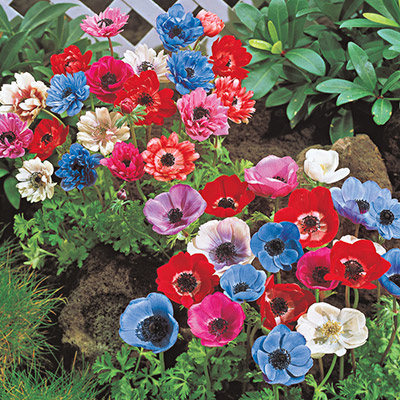
Anemones (Anemone)
Often growing 10-12 inches tall, Anemones have charming daisy-like flowers that open in late spring to early summer. Grown from corms, Anemones brighten the garden and cut-flower displays.
- Bloom time: Late spring to early summer
- Height: 10-12 inches
- Grow zones: 3-10, lifting in fall in zones 3-6
- Naturalizes well
- Great as cut flowers
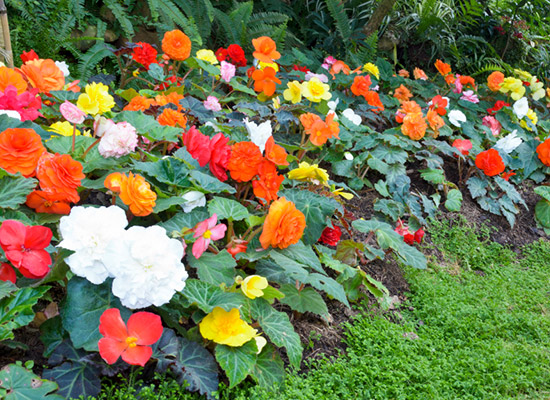
Begonias (Begonia)
Grown from tubers, Begonias are a favorite for hanging baskets and patio containers. The flowers are available in a range of hues and often quite large. Many begonias are grown in the shade or partial shade.
- Bloom time: Summer to first frost
- Height: 8-20 inches, depending on variety
- Grow zones: 3-10, lifting in fall in zones 3-8
- Can be grown in containers
- Deer tend to avoid
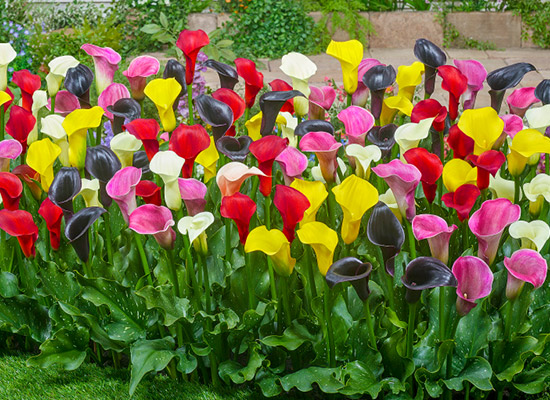
Calla Lilies (Zantedeschia)
Grown from rhizomes, Calla Lilies have elegant, cup-shaped blooms that are often used in wedding bouquets. Suitable for growing in containers or the garden, they are tender and must be dug up in the fall. Available in a wide range of colors, Calla Lilies bloom in early to midsummer.
- Bloom time: summer
- Height: 16-24 inches
- Grow zones: 3-10, lifting in fall in zones 3-8
- Great as cut flowers
- Deer tend to avoid
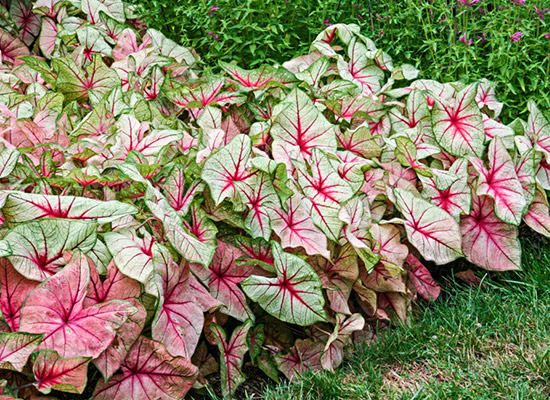
Caladiums (Caladium)
Grown for their showy foliage, Caladiums are a must-have for brightening up shaded areas. The heart-shaped leaves may include shades of red, pink, green and white. Caladiums are tender tubers and often planted in patio containers, hanging baskets and window boxes.
- Bloom time: foliage from summer until first frost
- Height: 12-24 inches
- Grow zones: 3-10, lifting in fall in zones 3-8
- Deer tend to avoid
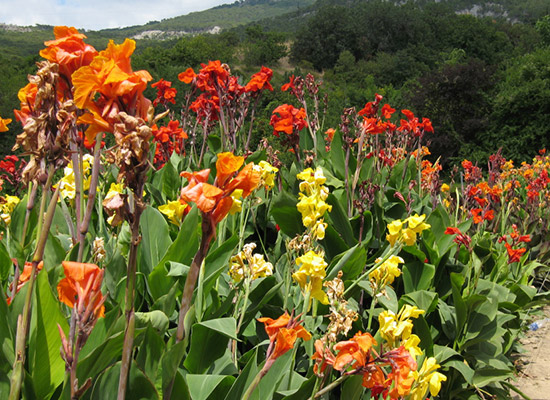
Cannas (Canna)
Their lush tropical foliage and showy, brightly colored flowers make flowerbeds come alive in the summer. Dwarf Cannas grow about 20 inches tall and can be grown in containers, while the traditional Cannas grow 36-60 inches tall. Grown from rhizomes, they’ve been long valued by municipal and park gardeners as well as home owners.
- Bloom time: summer until first frost
- Height: 24-60 inches, depending on variety
- Grow zones: 3-10, lifting in fall in zones 3-7
- Deer tend to avoid
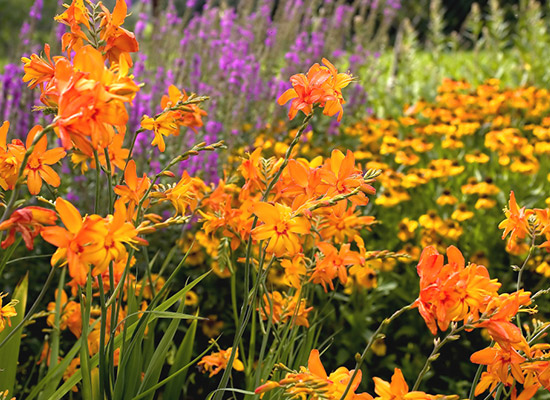
Crocosmia (Crocosmia)
Easy to grow and reliable bloomers, Crocosmia burst into bloom in midsummer and add vivid color to the garden and cut-flower displays. Growing 24-36 inches tall and available in many colors, they look best planted in groups. They are grown from corms.
- Bloom time: summer
- Height: 24-48 inches, depending on variety
- Grow zones: 3-9, lifting in fall in zones 3-6
- Attracts pollinators
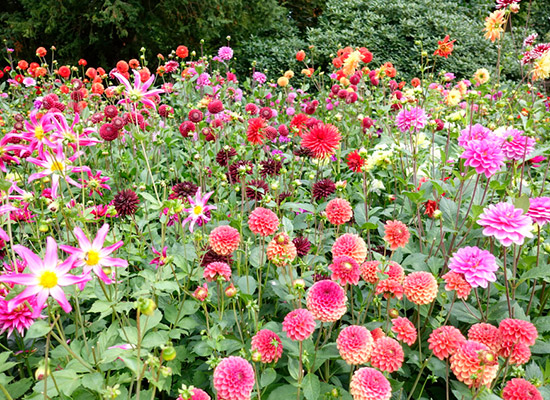
Dahlias (Dahlia)
An absolute must-have for the sunny garden, Dahlias produce showy blooms in an array of colors and flower forms from midsummer to frost. While they look stunning in the garden, they look fabulous in cut-flower arrangements and bouquets. Grown from tender tubers, they must be dug up in the fall in zones 7 and farther north.
- Bloom time: summer until first frost
- Height: 12-48 inches, depending on variety
- Grow zones: 3-10, lifting in fall in zones 3-7
- Great as cut flowers
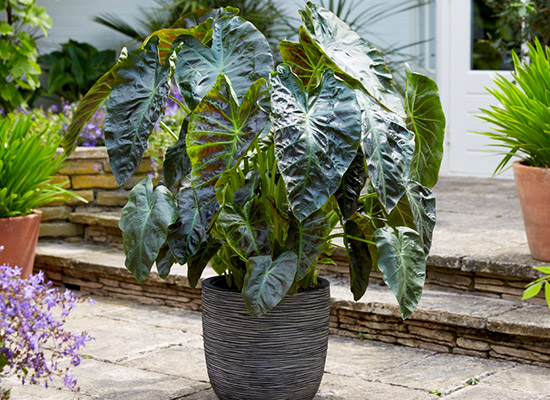
Elephant Ears (Colocasia/Alocasia)
These massive tropical plants with their giant leaves add a touch of the tropics to gardens. Grown from corms, many gardeners plant Elephant Ears in large patio containers and bring them indoors when cooler weather sets in.
- Bloom time: foliage from summer until frost
- Height: 3-9 feet, depending on variety
- Grow zones: 3-10, lifting in fall in zones 3-8
- Can be grown in containers
- Deer tend to avoid
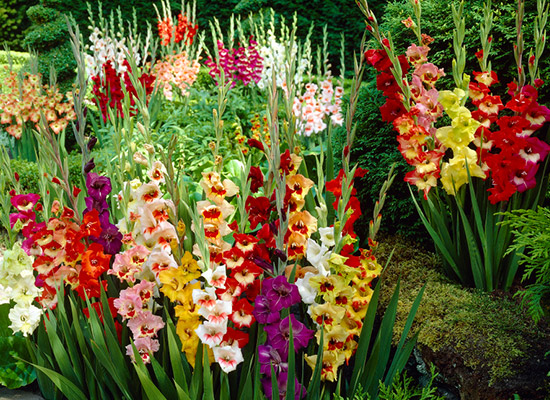
Gladiolus (Gladiolus)
A favorite for cut flowers, Gladiolus grow 36-48 inches tall and have 10-12 florets that grow along a stem. Available in an array of vivid colors, they bloom in mid to late summer. The petite Glamini Gladiolus grow about 24 inches tall and are suitable for containers. Grown from corms, Gladiolus must be dug up in the fall in zones 3-7.
- Bloom time: Late spring to early summer
- Height: 2-5 feet, depending on variety
- Grow zones: 3-10, lifting in fall in zones 3-7
- Great as cut flowers
- Deer tend to avoid
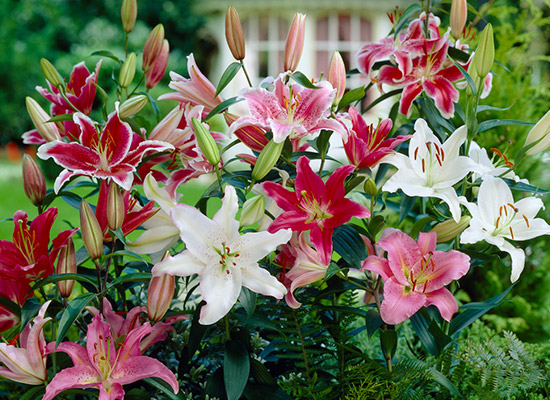
Lilies (Lilium)
With their trumpet-shaped flowers and low maintenance, Lilies are the darlings of the summer garden and cut-flower displays. Available in several types, including Asiatic, Oriental, Border, Double and Giant, they are grown from bulbs. Their bloom times vary from early to late summer. Many lilies are cold hardy and do not need to be lifted in the fall.
- Bloom time: summer
- Height: 1.5-6 feet, depending on variety
- Grow zones: 3-8
- Great as cut flowers.
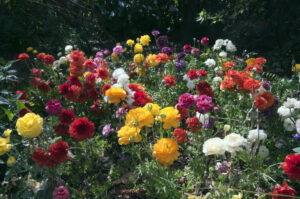
Ranunculus (Ranunculus)
Grown from corms, ranunculus flowers are a great addition to your summer landscapes and floral arrangements. Also known as Persian Buttercups, ranunculus show off large, peony-like, rounds blooms in a host of vivid colors over a long period.
- Bloom Time: Mid to late summer
- Height: 12 – 18 inches
- Grow Zones: 3-10, lifting in fall in zones 3-7
- Can be grown in containers
- Deer tend to avoid
- Great as cut flowers
- Attracts pollinators

Tuberoses (Polianthes)
The sweet, floral fragrance of tuberose flowers have made them one of the most sought-after blooms for fragrant cutting gardens and as a border plant. Though native to Mexico, tuberoses grow well in sunny northern landscapes. Lovely spikes of soft flowers appear in early summer and retain their beauty and sweet perfume all season long.
- Bloom Time: Early to late summer
- Height: 18 – 48 inches, depending on variety
- Grow Zones: 3-10, lifting in fall in zones 3-7
- Great as cut flowers
- Attracts pollinators
Tips and Tricks for Growing, Planting & Caring for Bulbs that Bloom in Summer
To get your spring bulbs off to a good start and have them grow into vibrant plants, make sure they have good drainage. If the soil is constantly soggy, the roots will rot.
Getting good drainage in a pot or container is easy. Just make sure the pot has drainage holes, place gravel in the bottom of the pot and add soil.
When planting your bulbs in the spring, you can test your flower bed for drainage by digging a hole that is 1-ft. deep and 1 ft. wide. Then fill the hole with water and record how long it takes for the water to completely drain. The ideal time is between 10 and 30 minutes. To improve your soil drainage, work lots of organic matter, such as aged manure, compost or peat moss into it.
If the soil has very poor drainage, you might want to consider growing bulbs in containers or raised beds.
How Do You Plant Bulbs in Spring for Summer Blooms?
No matter whether you’re planting true bulbs, corms, tubers or rhizomes, they all prefer well-drained soil that’s rich in organic matter. If the soil is not well-drained, the spring-planted bulbs could rot.
Where Do You Plant Summer-Flowering Bulbs?
When considering where to plant your bulbs take into account their light requirements. Some require full sun (six hours or more of direct sunlight daily), while others can grow in partial shade (usually defined as 2-6 hours of direct sunlight) or full shade (less than two hours of direct sunlight daily). Also take into account their mature height and spread. You want to give them space they need to spread out, and you want to plant them in a space in the garden where they can be seen but not block other flowers.
How Deep to Plant Spring-Planted Bulbs
The depth of planting for bulbs depends on their size. A good rule of thumb is that the depth should be three times the diameter of the bulb. Bulbs should be planted with the pointed end up.
How to Plant Bulbs in Pots
When planting bulbs in patio pots, window boxes or containers, plant the bulbs at the same depth you would if planting them in the ground. When planting bulbs in pots, make sure the pot has drainage holes, place a layer of gravel in the bottom of the pot, and then fill it with potting soil.
When to Fertilize Bulbs for Vibrant Summer Flowers
Fertilize flower bulbs at planting time. We recommend Van Bourgondien 100% Natural Bulb Food and suggest avoid using a strong commercial fertilizer or fresh manure at planting time. As a general guideline, you can feed again with a natural food when foliage and flower spikes emerge.
How to Time Your Planting for Summer-Flowering Bulbs
Most spring-planted bulbs are tender and susceptible to the cold. Therefore, if planting outdoors, wait until all danger of frost has passed in your area before planting your spring bulbs. Many gardeners start their tender bulbs indoors in the spring and then transplant them to the garden after danger of frost has passed.
How to Store Spring-Planting Bulbs
In many areas of the country, tender bulbs must be dug up, or lifted, in the fall, stored indoors over winter, and then planted in the spring. In the fall, after the plant’s foliage has withered or turned brown by a light frost, dig up the bulbs. Air dry the bulbs in a well-ventilated area for about a week. Do not dry the bulbs in the sun. After drying the bulbs, they can be stored in dry peat moss or wood shavings in a brown paper bag, open crate or netted bag. Store them at 50-55 degrees F. in a dry location until time to replant.

